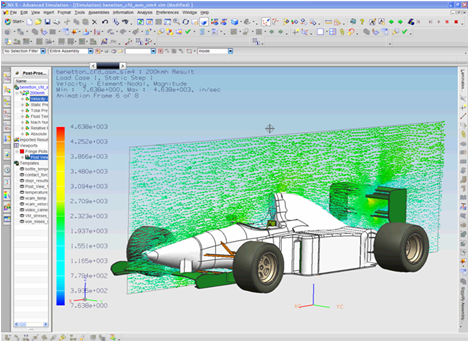NX Electronic Systems Cooling™
NX TMG Electronic Systems Cooling for NX Advanced Simulation environment is an industry-specific vertical application that leverages the NX Flow and NX Thermal solvers as well as the PCB.xchange and other high tech and electronics industry-specific cooling capabilities in a bundle product. It provides a comprehensive set of tools to simulate 3D air flow and thermo-fluid behaviour in high tech and electronic systems.


NX Electronic Systems Cooling helps resolve thermal engineering challenges early in the design process and is a valuable aid in understanding the physics of fluid flow and heat transfer for electronic enclosures and cooling applications.
Some practical applications
- Determining electronic systems cooling strategies
- Enclosure, subsystem and power supply thermal management
- Detailed thermal design of PC boards and multi-chip modules
- Thermally sensitive and critical components placement
- Heat sinks modeling
- Spacing requirements between critical parts
- Predicting fan operating conditions
- Volume and mass flow estimations
- Computing pressure inlet/outlet gradients and head losses
- Identifying recirculation areas and hot spot issues
- NX Electronic Systems Cooling has an interface with EDA design systems for direct and bi-directional PCB and FPC data exchanges. All of the leading PCB and FPC layout software packages are supported:
- Zuken
- Mentor Graphics
- Cadence
- VeriBest
- OrCAD
- Incases
- Comtel
Main NX Electronic System Cooling features
- Specific capabilities for electronics simulation applications
- Heat sink models library and heat sink modeler
- Electronic thermal component library
- Fan catalogue (database of fan curves) with more than 2000 fans from leading manufacturers
- PCB modeler/xchange (ECAD/MCAD bi-directional data exchange)
- NX Electronic Systems Cooling general simulation capabilities
- Steady-state and transient analysis (adaptive correction multigrid solver)
- Turbulent (k-εe, mixing length), laminar and mixed flows
- Internal or external flows
- Automatic skin mesh (boundary layer mesh) with unlimited layer options
- Complete set of automatic and/or manual meshing options for the selected fluid domains
- Unstructured fluid meshes (supports any combination of tetrahedral, brick, pyramid and wedge elements-linear and parbolic types)
- Multiple 1st and 2nd order advection with or without flux limiters
- Efficient time stepping and other algorithms for fast transient calculations
- Solution intermediate results recovery allowing solver restart
- Heat loads and temperature restraints on the fluid domain
- Forced, natural and mixed convection
- Fluid buoyancy
- Multiple enclosures
- Multiple fluids
- Losses in fluid flow due to screens, filters and other fluid obstructions (including orthotropic porous blockages)
- Head loss inlets and openings (fixed or proportional to calculated velocity or squared velocity)
- Fluid swirl at inlet and internal fans
- Fluid recirculation loop with head loss, heat loss, heat input/loss or fluid temperature change between unconnected fluid regions
- Automatic connection between disjoint fluid meshes
- Altitude effects
- Nonlinear flow boundary conditions
- Nonlinear thermal contacts
- Thermal couplings (welded, bolted, bonded, and other thermal contacts) for assembly modeling
- Disjoint thermal/fluid meshes support in assembly modeling
- Surface-to-surface radiative heat transfer
- Thermal solution customization (user subroutine)
- Hemicube-based view factor calculation (using graphics card hardware)
- Radiation enclosures
- Radiative sources
- Diurnal solar environmental heating (including cloud, altitude, longitude and latitude effects, pollution and other solar attenuation effects)
- Specular and transmissive surfaces
- Hydraulic fluid networks
- Joule heating
- Heater and thermostat modeling
- Peltier cooler modeling

